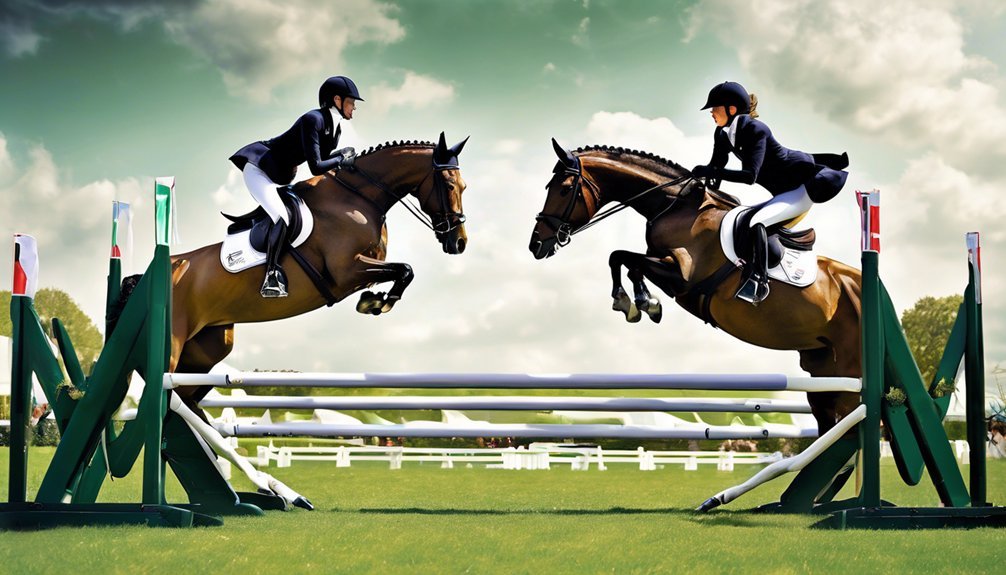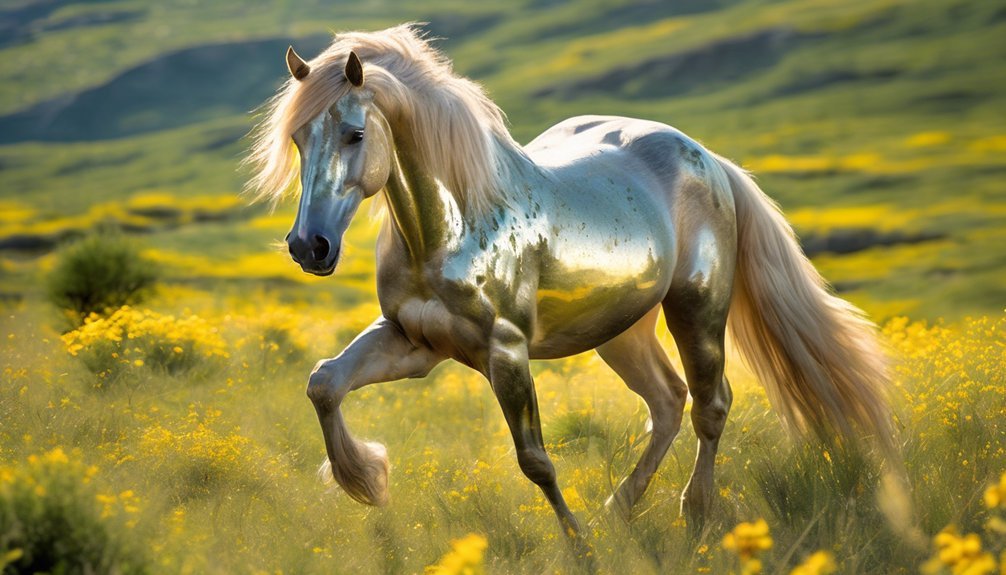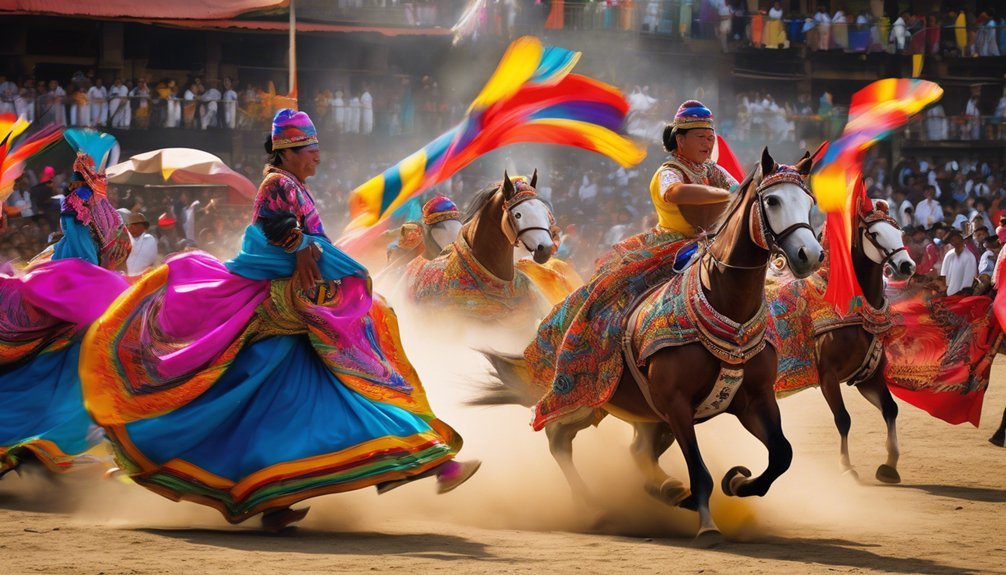
You might think show jumping and dressage are just two sides of the same equestrian coin, but they each demand unique skills and philosophies. While show jumping emphasizes speed and agility, dressage focuses on precision and harmony. Understanding these differences can enhance your appreciation for both disciplines. But what specific elements set them apart, and how do they shape the rider's experience? Let's explore these distinctions further.
Key Takeaways
- Show jumping emphasizes speed and obstacle navigation, while dressage focuses on precision and harmonious movements with the horse.
- Scoring systems differ: show jumping awards penalties for faults, while dressage scores movements on a scale from zero to ten.
- Equipment and attire vary; show jumping uses close-contact saddles and flexible attire, whereas dressage employs deeper seat saddles and formal wear.
- Training approaches differ: show jumping requires quick decision-making and adaptability, while dressage prioritizes systematic skill progression and synchronization.
- Personal preferences influence discipline choice; show jumping appeals to thrill-seekers, while dressage attracts those who value artistry and precision.
The Origins of Show Jumping and Dressage

The roots of show jumping and dressage trace back to the military and agricultural needs of ancient civilizations.
You'll discover that their historical evolution reflects a blend of practicality and artistry. Initially, these disciplines served functional purposes, training horses for warfare and farm work.
Over time, cultural influences shaped their development, transforming utilitarian skills into refined sports. In Europe, the Renaissance sparked a renewed interest in horsemanship, providing a foundation for dressage as an expression of elegance and precision.
Meanwhile, show jumping emerged from the need for agility and speed.
As you explore their origins, you'll appreciate how these equestrian arts have evolved, melding history with culture, and revealing a rich tapestry of human-animal partnership.
Key Objectives in Show Jumping
In show jumping, mastering course navigation skills is crucial for successfully maneuvering through obstacles.
You'll need to balance speed and timing to achieve the best performance while minimizing faults and penalties.
Understanding these key objectives not only enhances your technique but also elevates your competitive edge.
Course Navigation Skills
While navigating a show jumping course, you'll quickly realize that sharp course navigation skills are essential for success. Understanding the course layout is your first step; it helps you visualize your path and anticipate each turn.
As you prepare, think about how to tackle each jump and the rhythm required for effective obstacle navigation. You'll need to be aware of distances between jumps, angles, and the heights of obstacles, adjusting your approach accordingly.
Practicing these skills not only builds your confidence but also fosters a deeper connection with your horse. Remember, each course is unique, and adapting to its specific challenges is key.
Mastering course navigation will elevate your performance and enhance your overall experience in the arena.
Speed and Timing
Achieving the right balance of speed and timing is crucial for success in show jumping, as these elements directly impact your performance and overall score.
You need to develop timing strategies that not only enhance your horse's rhythm but also allow for necessary speed adjustments throughout the course.
- Focus on your horse's natural pace and adjust accordingly.
- Anticipate jumps to maintain momentum.
- Practice different speed scenarios during training.
- Use your body language to signal timing changes.
- Analyze your rounds to identify areas for improvement.
Faults and Penalties
Understanding faults and penalties is essential for mastering show jumping, as these factors can significantly affect your score and overall performance.
In this sport, there are various fault types, including knocking down a rail, refusals, and time penalties. Each of these faults leads to specific penalty assessments that can quickly add up. For instance, a rail knocked down incurs four faults, while a refusal may add up to elimination in some cases.
Being aware of these rules helps you strategize your approach, ensuring you maintain accuracy and speed. By minimizing faults and understanding their consequences, you enhance your chances of success, making every ride not just a challenge but an opportunity for growth in your show jumping journey.
Key Objectives in Dressage
In dressage, your key objectives focus on precision and accuracy, ensuring every movement is executed flawlessly.
You also aim for harmony with your horse, creating a seamless partnership that enhances performance.
Additionally, emphasizing training progression allows you to build skills systematically, setting the stage for continued improvement and success.
Precision and Accuracy
While many equestrian disciplines emphasize speed and agility, dressage places a premium on precision and accuracy, making them foundational elements of the sport.
You'll need to master precision techniques that refine your horse's movements, ensuring every step is deliberate and exact. Each performance is an accuracy assessment where judges evaluate your control and finesse.
- Synchronization between horse and rider
- Clear transitions between gaits
- Exactness in geometric patterns
- Timely responses to cues
- Consistent rhythm and tempo
Harmony With Horse
Achieving harmony with your horse is a fundamental goal in dressage, reflecting the deep connection and mutual understanding between rider and mount.
This intimate bond hinges on effective equine communication, where you learn to interpret your horse's subtle cues and responses. As you progress, you'll notice how synchronized movements become a natural extension of your partnership.
Each stride, each transition, is a dance of trust and respect. The more you engage with your horse, the better you'll understand its needs and emotions, allowing for a seamless flow in your routines.
This harmony not only enhances performance but also enriches your experience, turning every ride into a profound expression of collaboration and unity.
Embrace this journey, and watch your connection deepen.
Training Progression Focus
To excel in dressage, it's essential to focus on key objectives that guide your training progression. By honing in on these elements, you'll achieve significant progression milestones that elevate both you and your horse.
- Develop rhythm and relaxation for a solid foundation.
- Enhance connection and communication through effective training techniques.
- Build strength and flexibility to improve your horse's performance.
- Master the basics before advancing to complex movements.
- Set realistic goals to track your progress and celebrate achievements.
These objectives not only create a structured approach to your training but also deepen the bond with your horse.
The Importance of Training and Preparation

Effective training and preparation are crucial for both show jumping and dressage, as they lay the foundation for success in these demanding equestrian disciplines. You'll find that employing the right training techniques and preparation strategies significantly boosts your performance.
| Training Techniques | Preparation Strategies |
|---|---|
| Groundwork exercises | Setting a practice schedule |
| Progressive jumping drills | Mental visualization |
| Dressage pattern practice | Fitness conditioning |
| Consistent feedback | Goal setting |
Equipment and Attire Differences
While both show jumping and dressage require specialized equipment and attire, the differences reflect the unique demands and aesthetics of each discipline.
In show jumping, you might opt for a close-contact saddle that allows for quick movements, while dressage often employs a deeper seat saddle for better communication with your horse.
Your rider attire also varies significantly; in dressage, formal attire is essential, including a tailcoat and top hat, whereas show jumping allows for more flexibility, often featuring tailored jackets and boots.
- Saddle types: close-contact vs. deep seat
- Rider attire: formal vs. tailored
- Helmets: standard safety vs. traditional styles
- Spurs: subtle use in dressage vs. show jumping
- Gloves: often mandatory in dressage, optional in jumping
Competition Formats and Scoring
Competition formats and scoring systems in show jumping and dressage reflect the distinct objectives of each discipline.
In show jumping, you're focused on completing a course of jumps while minimizing faults like refusals or knockdowns, with time often being a deciding factor. The scoring system typically awards points based on penalties incurred, and the fastest clear round wins.
Conversely, dressage emphasizes precision, grace, and harmony between horse and rider. Scoring in dressage is based on a numerical system, with judges evaluating movements on a scale from zero to ten. Your final score is the sum of these evaluations, reflecting the overall quality of your performance.
Understanding these formats and systems is crucial for appreciating the nuances of each sport.
The Role of the Horse and Rider Partnership

The bond between horse and rider is crucial in both show jumping and dressage, as it directly influences performance outcomes. This partnership relies on effective communication styles and mutual trust, which can be built through consistent training and shared experiences.
When you understand your horse's needs and responses, you create a harmonious connection that enhances your performance.
- Clear signals lead to better responses.
- Trust fosters confidence in both horse and rider.
- Shared experiences strengthen emotional bonds.
- Understanding each other's strengths and weaknesses is vital.
- Consistent practice deepens communication and connection.
In both disciplines, a strong partnership allows for fluid movements, making you both a cohesive unit, ready to tackle challenges together.
Choosing the Right Discipline for You
How do you decide which equestrian discipline suits you best: show jumping or dressage? Start by reflecting on your personal interests. If you thrive on adrenaline and enjoy the thrill of tackling obstacles, show jumping might be your calling.
Conversely, if you appreciate precision and harmony with your horse, dressage could be a better fit.
Next, consider your skill levels. Are you a beginner, or do you have some experience under your belt? Show jumping often requires quick decision-making and agility, while dressage emphasizes technique and patience.
Whichever discipline you choose, remember that it should resonate with your passion and goals. Ultimately, the right path will enhance your connection with your horse, making every ride an enjoyable experience.
Frequently Asked Questions
Can Beginners Participate in Show Jumping or Dressage?
Absolutely, you can participate in both disciplines as a beginner. Focus on beginner training to build your skills, and you'll gain competition readiness. Each offers unique experiences that can enhance your riding journey and confidence.
What Breeds Are Best Suited for Show Jumping and Dressage?
When considering breeds for show jumping and dressage, Thoroughbreds excel in agility, while Warmbloods offer strength and versatility. You'll find each breed brings unique advantages, enhancing your experience and potential in these equestrian disciplines.
How Long Does It Take to Train for Competitions?
You might think competition preparation is a sprint, but it's really a marathon. Training duration varies, typically taking months to years, depending on your goals, horse's experience, and your dedication to the craft.
Are There Age Restrictions for Competitors in These Disciplines?
Yes, there are age restrictions for competitors. Different age classes exist, determining competition eligibility. These guidelines ensure fair play and encourage youth involvement, allowing you to grow and develop your skills alongside others in your age group.
What Are Common Injuries Associated With Show Jumping and Dressage?
You might picture a rider gracefully navigating a course, but common injuries like strains and falls can occur. Injury prevention through proper training and equipment is essential for keeping both you and your horse safe.
Conclusion
In summary, while show jumping and dressage may seem worlds apart, they both demand exceptional skill and dedication. Did you know that in 2021, the global equestrian industry was valued at over $300 billion, highlighting the immense popularity and impact of these disciplines? Whether you're drawn to the thrill of jumping or the elegance of dressage, understanding these differences helps you choose the path that resonates with your passion and strengths as a rider.





